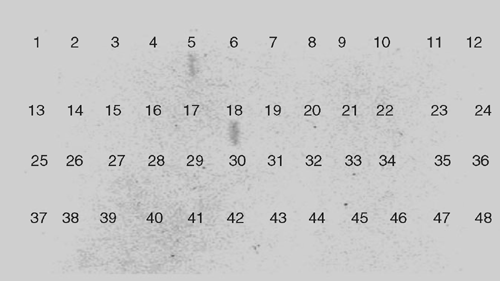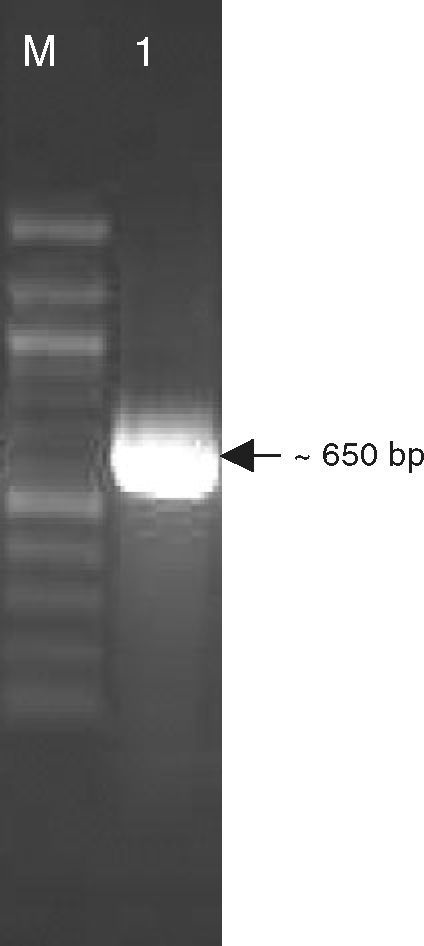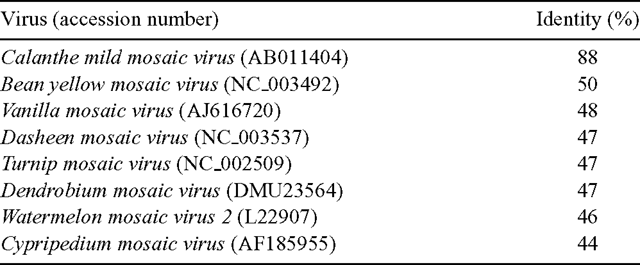A potyvirus in Cymbidium spp. in northern India
M. K. Singh A , A. R. Sherpa A , V. Hallan A and A. A. Zaidi A BA Plant Virology Laboratory, Floriculture Division, Institute of Himalayan Bioresource Technology, Palampur-176 061, Himachal Pradesh, India.
B Corresponding author. Email: zaidi_aijaz@yahoo.com
Australasian Plant Disease Notes 2(1) 11-13 https://doi.org/10.1071/DN07005
Submitted: 18 October 2006 Accepted: 20 December 2006 Published: 1 February 2007
Abstract
A potyvirus was isolated from diseased Cymbidium pendulum and C. tigrinum epiphytic orchids collected from Sikkim in northern India. ELISA, RT-PCR and Northern blot analysis revealed the association of potyvirus infection with disease symptoms. The sequencing of a RT-PCR-amplified amplicon using potyvirus group-specific primers showed that this virus is distinct but most closely related to Calanthe mild mosaic virus. This paper reports the occurrence of potyvirus in wild orchids especially in Cymbidium spp.
Potyviridae are one of the largest and most economically important families of plant viruses. Orchids are the largest family of flowering plants with ~30 000–35 000 species and they form a large part of the floriculture trade. Odontoglossum ringspot tobamovirus and Cymbidium mosaic potexvirus are the most frequently reported viruses in cultivated orchids, perhaps because both are highly contagious and spread by wounding when plants are pruned or divided for repotting. However, at least a dozen viruses, mostly potyviruses, have been recorded in orchids, including vanilla (Brunt et al. 1996). Most viruses are a serious threat to the orchid industry as they reduce the vigour of infected plants and decrease flower quality. The potyviruses previously isolated from orchids include Dendrobium mosaic (DeMV), Habenaria mosaic, Pecteilis mosaic, Vanilla mosaic and Vanilla necrosis potyviruses (Brunt et al. 1996). The polymerase chain reaction (PCR) has been shown to be very useful for detecting and characterising plant pathogens and is more sensitive than direct probing or serological techniques (Hadidi et al. 1995). There are now many published reports of the use of reverse transcription–PCR (RT-PCR) with degenerate primers, which produce specific DNA fragments from all species of a group.
A survey was undertaken for screening of major viruses infecting orchids, which revealed widespread occurrence of Cymbidium mosaic virus (CymMV) and Odontoglossum ringspot virus (ORSV) in Indian orchids (Sherpa et al. 2006a, 2006b). However, some plants of Cymbidium pendulum and C. tigrinum with symptoms of mild mosaic and stunting gave negative results for CymMV and ORSV. These epiphytic orchids grow as wild plants in Sikkim, in the north-eastern region of India. These plants were further tested using Cucumber mosaic virus, Cymbidium ringspot virus and potyvirus group-specific antibodies. ELISA tests using potyvirus group-specific antibodies indicated the association of a potyvirus with diseased orchid samples. To further elucidate and confirm the identity of the virus, total RNA was extracted from the diseased leaves of C. pendulum and C. tigrinum using the RNAqueousTM Kit (Ambion, USA). RT-PCR was performed as described by Van der Vlugt et al. (1999) using the primer pair ‘cp9502’ (5′GCGGATCCTTTTTTTTTTTTTTTTT3′), specific for 3′ end of potyvirus genomes, and ‘cpup’ (5′TGAGGATCCTGGTGYATHGARAAYGG-3′, where Y = C or T, H = A, T or C, R = A or G), which hybridises with the coat protein region of potyvirus genomes. The cDNA was reverse transcribed in a 25-µL reaction mixture using 7 µL (1–2 µg) RNA, 0.2 µg reverse primer (cp9502), 2 µL of 40 mM dNTP mix, 10 units of human placental RNase inhibitor, 5 µL of 5× RT buffer and 200 units of M-MLV reverse transcriptase enzyme. The reaction mixture was incubated at 42°C for 75 min and after that it was incubated at 70°C for 5 min. PCR amplification was done in a GeneAmp PCR 9700 system (Applied Biosystems, USA) with a 50-µL reaction mixture containing 7 µL cDNA, 0.2 µg forward primer, 0.2 µg downstream primer, 5 µL of 10× PCR buffer, 3 µL of 10 mM dNTP mix and 1.5 units of Taq DNA polymerase. The DNA was amplified using 35 cycles of denaturation at 94°C for 1 min, annealing at 54°C for 2 min and elongation at 72°C for 1 min, and a final elongation at 72°C for 10 min. The amplified PCR-product was fractionated in a 1% agarose gel and then stained with ethidium bromide.
The amplified fragment was cloned into a pGEM-T Easy vector (Promega, USA) and was then sequenced and digested with EcoRI and used for probe preparation. DNA was mixed properly with a random hexamer mixture (100 ng), 10× Klenow buffer, 10 mM dNTPs (-dATP), alpha 32P dATP and Klenow enzyme (5U/μL) in a reaction mixture of 30 μL. The mixture was centrifuged briefly and kept at 37°C for 1 h followed by incubation on ice for 5 min.
Northern slot blot hybridisation (Fig. 1) was carried out with slight modification of the methods described in ExpressHyb Hybridization Kit (BD Bio Sciences, USA). ExpressHyb solution was warmed at 68°C and stirred well to completely dissolve any precipitate. Membranes (10 × 10 cm) were prehybridised in a minimum total volume of 5–10 mL of ExpressHyb solution with continuous shaking at 68°C for 30 min. An equal volume of buffer A (500 mM Tris-HCl, 500 mM NaCl, 5 mM EDTA, 0.5% SDS) was added to the radioactively labelled DNA probe and denatured at 95–100°C for 2–5 min. Then it was chilled quickly on ice and added to 5–10 mL of fresh ExpressHyb hybridisation solution. ExpressHyb hybridisation solution was replaced with the fresh solution containing the radiolabelled DNA probe. All air bubbles were removed from the container and hybridisation solution was evenly distributed over the entire blot. It was incubated with continuous shaking at 68°C for 1 h and the blot was rinsed with wash solution I at room temperature for 30–40 min with continuous agitation with four changes of fresh wash solution I. The blot was washed in wash solution II with continuous shaking at 50°C for 40 min with one change of fresh solution. The blot was removed with forceps and excess wash solution was drained off. Immediately, the blot was put on Whatman paper and wrapped with plastic wrap. The X-ray film was exposed to the blot at –70°C with two intensifying screens and developed after overnight incubation.

|
These tests showed the presence of a potyvirus in the diseased orchids. In this survey, fifty orchid species and hybrids representing 10 genera, including Aerides multiflora, Coelogyne cristata, Cymbidium aloifolium, C. iridiodes, C. pendulum, C. tigrinum, Cymbidium hybrid (Great flower), Dendrobium nobile, Epidendrum sp., Phaius tankervillae, Pholiodota sp., Rhynchostyly retusa, Strauropris undulata and Vanda spp., were collected from different nurseries and local habitats in Sikkim and were tested for the presence of potyviruses. Their presence was detected by ELISA, RT-PCR and Northern blot in C. pendulum and C. tigrinum. These are epiphytic orchids found growing naturally in the Sikkim region. In nature, these wild virus-infected plants exhibit only mild mosaic along with growth retarded symptoms. In RT-PCR, a fragment of ~650 bp (Fig. 2) was amplified, including a sequence of 453 bp that was homologous to the 3′ coat protein gene and 3′ non-coding region of potyviruses. The 3′ non-coding region is 173 nucleotides long and is followed by a polyA tail. The sequence of the PCR-amplified fragment from C. pendulum was submitted to EMBL GenBank as Accession Code No: AJ871476. It showed 88% identity with Calanthe mild mosaic virus (AB011404), 50% with Bean yellow mosaic virus (NC_003492), 48% with Vanilla mosaic virus (AJ616720), 47% with Dasheen mosaic virus (NC_003537), Turnip mosaic virus (NC_002509) and Dendrobium mosaic virus (DMU23564), 46% with Watermelon mosaic virus 2 (L22907) and 44% with Cypripedium mosaic virus (AF185955) at the nucleotide level (Table 1) and it was tentatively named Cymbidium potyvirus. This is the first report of a new potyvirus infecting C. pendulum and C. tigrinum orchids from natural habitats of Sikkim, and is only the second report of a virus in a wild orchid as all previous records are of virus infection in cultivated orchids (Gibbs et al. 2000).

|

|
Acknowledgements
We are thankful to the Director, IHBT, Palampur, for necessary facilitues and to DBT, Government of India, for financial support (Project no. BT/PR/1790/AGR/08/126/99). IHBT communication Number: 0158.
Gibbs A,
Mackenzie A,
Blanchfield A,
Cross P,
Wilson C,
Kitajima E,
Nightingale M, Clements M
(2000) Viruses of orchids in Australia; their identification, biology and control. Australian Orchid Review 65, 10–21.

Sherpa AR,
Hallan V,
Pathak P, Zaidi AA
(2006a) Coat protein gene of Cymbidium mosaic virus: Characterization of geographical isolates from India. Journal of Phytopathology 154, 275–280.
| Crossref | GoogleScholarGoogle Scholar |

Sherpa AR,
Bag TK,
Hallan V,
Pathak P, Zaidi AA
(2006b) The detection of Odontoglossum ringspot virus in orchids from Sikkim, India. Australasian Plant Pathology 35, 69–71.
| Crossref | GoogleScholarGoogle Scholar |

Van der Vlugt RAA,
Steffens P,
Cuperus C,
Barg E,
Lesemann DE,
Bos L, Vetten HJ
(1999) Further evidence that shallot yellow stripe virus (SYSV) is a distinct potyvirus and reidentification of Welsh onion yellow stripe virus as a SYSV Strain. Phytopathology 89, 148–155.



